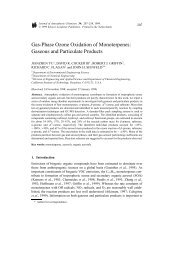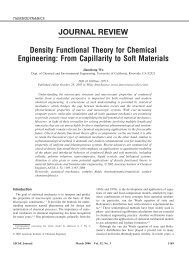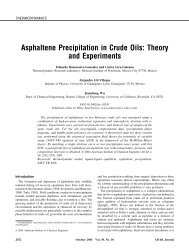DEVELOPMENT OF REVISED SAPRC AROMATICS MECHANISMS
DEVELOPMENT OF REVISED SAPRC AROMATICS MECHANISMS
DEVELOPMENT OF REVISED SAPRC AROMATICS MECHANISMS
You also want an ePaper? Increase the reach of your titles
YUMPU automatically turns print PDFs into web optimized ePapers that Google loves.
1.2<br />
Normalized Relative Intensity (photon flux)<br />
(arbitrary units)<br />
1.0<br />
0.8<br />
0.6<br />
0.4<br />
0.2<br />
0.0<br />
0.9<br />
0.6<br />
0.3<br />
(Normalized to give the<br />
same NO 2 photolysis rate)<br />
Solar Z=60<br />
Argon Arc (UCR EPA)<br />
Xenon Arc (UCR Other)<br />
Black Lights (UCR Other)<br />
Solar Z=60<br />
Black Lights (UCR Other)<br />
Mixed Lights (TVA)<br />
Blue Lights (CSIRO)<br />
0.0<br />
Relative Action Spectrum or<br />
Absorption Cross-Section<br />
1.0<br />
0.8<br />
0.6<br />
0.4<br />
0.2<br />
(Relative to maximum for<br />
wavelength >300 nm)<br />
0.0<br />
0.30 0.35 0.40 0.45 0.50 0.55 0.60 0.65 0.70<br />
O3 -> O2 + O1D<br />
RCHO -> Radicals<br />
AFG1 -> Radicals<br />
NO2 -> NO + O3P<br />
Methyl Glyoxal -> Radicals<br />
Glyoxal -> Radicals<br />
NO3 Absorption<br />
(In order of increasing<br />
wavelength region)<br />
Wavelength (nm)<br />
Figure 4.<br />
Relative spectral distributions of light sources for the chamber experiments used for<br />
mechanism evaluation. Action spectra or absorption cross sections for selected photolysis<br />
reactions are also shown.<br />
model performance being different when different light sources are used. Although some compounds only<br />
have mechanism evaluation data using blacklights, a few compounds, particularly toluene and m-xylene,<br />
have a large number of mechanism evaluation experiments with arc lights as well as blacklights. These<br />
data can be used to assess whether there is a significant effect of light source on mechanism evaluation<br />
results. This is discussed further in the “Discussion” section of this report.<br />
In addition to the aromatics - NO x runs listed in Table B-1, the updated mechanism was also<br />
evaluated by simulating the results of incremental reactivity experiments where the effects of adding an<br />
aromatic compound to a base case reactive organic gas (ROG) surrogate - NO x experiment. Since no new<br />
incremental reactivity experiments with aromatics were conducted since the <strong>SAPRC</strong>-07 mechanism was<br />
developed, these are a subset of the incremental reactivity experiments used in the <strong>SAPRC</strong>-07 evaluation.<br />
These experiments are listed in Table B-2, along with selected conditions and results. See Carter (2010a)<br />
for a more complete discussion of these incremental reactivity experiments. The types of incremental<br />
reactivity experiments carried out are summarized on Table 10<br />
36
















